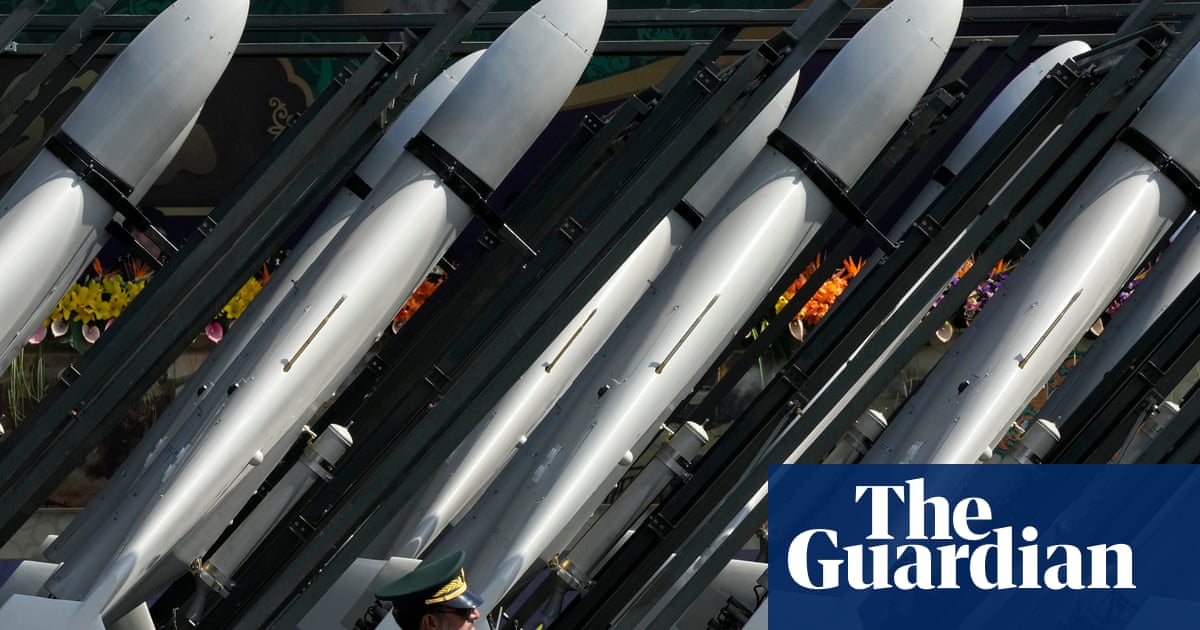
After an estimated 165 attacks on US bases in the Middle East since 7 October, it was inevitable one would eventually get through. For the first time, it is believed, US troops were killed from the air by an enemy drone: three US army reservists died and more than 80 were wounded in last weekend’s attack on Tower 22, a little-known logistics base near Jordan’s border with Syria.
The attack, the Pentagon said, had “the footprints of Kataib Hezbollah”, an Iran-aligned militia in Iraq. Joe Biden, the US president, added that he held Tehran responsible “in the sense that they’re supplying the weapons” – the fast proliferating, relatively cheap drones that are changing the nature of warfare.
“Imagine it was the 1990s,” said Fabian Hinz, a Middle East weapons expert with the International Institute for Strategic Studies. “What militia groups like Kataib Hezbollah could have done is target a US base with a few rockets. Now they can do lots more damage with a greater reach: even the smallest drones can have very long ranges and they can be very precise.”
The exact model of the drone that smashed in the middle of the night into a living quarters at Tower 22 is not known, though US officials have briefed it was “a type of Shahed drone”. If that is correct, it is most likely to the smaller Shahed 101 or delta winged Shahed 131, both believed to be in Kataib Hezbollah’s arsenal, Hinz said, with estimated ranges of at least 700km (434 miles) and a cost of $20,000 (£15,700) or more.
The drones’ designer and likely manufacturer is Shahed Aviation Industries Research Center, an Iranian company subordinate to the country’s Islamic Revolutionary Guard Corps, according to the US. Its manufacturing efforts have taken off over the past five years, fuelled by a series of conflicts and Iran’s foreign policy ambitions, stemming from a history of necessity supported by sophisticated innovation.
Iran has a long history of testing and deploying drones, dating back to the Iran-Iraq war of the 1980s, an effort driven partly by the country’s lack of access to high end western technology that would enable it to purchase, develop and maintain a sophisticated air force. But in September 2019, an extraordinary drone and missile attack on two Saudi oil installations at Abqaiq and Khurais, which temporarily knocked out 5% of the world’s oil supply, suggested a different leap forward.
At the time, Saudi Arabia was embroiled in Yemen’s civil war, fighting against Houthi rebels, who are allied to Iran. Although the attack was claimed by the Houthis, the Saudis said the drones, of a then unknown delta wing type, came from the north, not from Yemen to the south, and blamed Iran. Though not yet named, those drones have been subsequently identified as Shahed 131s.
The unknown delta wing drone reappeared in July 2021, in an attack on an Israeli owned oil tanker, Mercer Street, in which a Briton and a Romanian were killed. Dominic Raab, then the foreign secretary, said Iran was probably responsible. The existence of the new drone was not formally acknowledged by Iran until December, with Iran developing a scaled up Shahed-136 alongside the 131.
A few months later, Russia invaded Ukraine, and after its initial effort at conquest failed, it began searching for new weapons. Iran was one of the few countries, along with North Korea, willing to sell Moscow weapons. It agreed to supply Shahed 136s, first seen on the battlefield in autumn 2022. A Ukrainian commander said a Shahed destroyed an M777 howitzer during the Kharkiv counteroffensive: “Instead of firing 100 artillery shells, it’s easier to release one of these drones.”
Within a few weeks, Shahed drones were widespread in Ukraine, distinctive not just from their shape but their noisy engine, sounding somewhere between a lawn mower and a moped. An attack on central Kyiv on 17 October that year made them headline news: four people were killed in a terrifying attack as Shaheds swirled over the city centre, a handful eluding desperate attempts to shoot them down by firing from the ground.
Shahed 136 drones have a light carbon fibre airframe and range of more than 1,500 miles, enabling Russia to fly them from Belarus in the north and occupied areas in the south to target Ukraine’s cities. They can carry 20-40kg of explosives, around double the 131 and enough to “blow in a pretty big hole in a non hardened structure” according to Justin Bronk, an aviation analyst at the Royal United Services Institute.
The drones, Bronk adds, are best considered cheap substitutes for guided cruise missiles, most effective against soft or “static structures” which force those under threat to “either invest money in defences or disperse and relocate which renders things like aircraft on bases more inefficient”. Flight paths are normally pre-programmed and can be quite complex, and Shaheds often use a sophisticated combination of US, Russian and Chinese navigation systems to make them harder to jam, according to Bronk.
Shahed drone attacks in Ukraine continue. In November a record 75 targeted Kyiv, although their growing familiarity and slow speed has made them easier to neutralise: 71 were shot down, Ukrainian officials said. But evolution of the technology continues. Iran developed a faster jet engine powered Shahed 238 last November, able to fly at well over twice the speed of the 136, and which is believed to have been fired into Ukraine last month.
The technology also suits Tehran: Shahed drones can be easily supplied to Iran’s regional allies, the Houthis or the self-styled resistance militias in Iraq or Syria, in whole or in components. Though Russia has used them overtly, drones can be used deniably, as at Abqaiq or most recently in the Tower 22 attack, where even the US has taken its time to firmly attribute responsibility.
In Yemen, they are reassembled and the designs sometimes refined, and since 7 October they have been used repeatedly by the Houthis in their attacks on western shipping in the southern Red Sea and the Gulf of Aden, and even to target western warships directly. So far the Houthi attacks on warships have all failed, but the most significant attack on 9 January demonstrated an asymmetric effect.
Seven out of 18 Houthi drones were shot down by Britain’s HMS Diamond using a mixture of cheaper gun fire and Sea Viper or Aster missiles which cost £1m to £2m each. It is a simple illustration of how the drones impose costs on defenders fending off the new class of weapons. Similar calculations apply in Ukraine and elsewhere, but often the reality is that the human or economic cost of a drone attack succeeding, as happened at the weekend, is higher.
“What Iran is demonstrating is that a relatively robust capability need not be very advanced and virtually any military force can afford any number of drones,” said Samuel Bendett, a drone specialist at the US Center for Naval Analyses, suggesting it is likely that the technology will only spread further. “Rather than investing in more expensive combat capabilities, this shows it is cheaper to buy a drone and hope it either hits something or your enemy expends resources shooting it down.”












